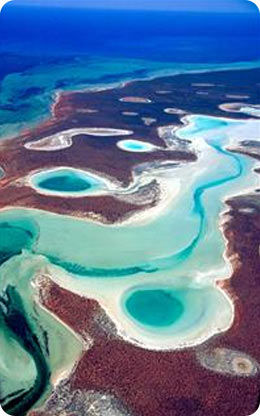Shark Bay, at the westernmost tip of Australia, is like a land that time forgot. It’s home to a host of plant species that are found nowhere else, several endangered species of mammals, and rock-building microbes like those that inhabited Earth three-and-a-half billion years ago. What it doesn’t have much of is people, and that’s one reason why it has so much of everything else.
 Aerial view of Big Lagoon in Shark Bay. Credit: www.sharkbay.org © DEC/ Rory Chapple
Aerial view of Big Lagoon in Shark Bay. Credit: www.sharkbay.org © DEC/ Rory ChappleThe region covers several thousand square miles. It’s far away from any big cities, and only a couple of thousand people live along its thousand miles of coastline.
With little development or pollution, Shark Bay is home to an astounding variety of life. That includes one of the world’s largest populations of dugong, a relative of the manatee. The region also hosts five species of endangered land mammals.
The bottom of the bay is covered with seagrass beds, including the largest individual bed in the world. Over the last few millennia, those beds have helped close off parts of the bay, making them up to twice as salty as the oceans.
That’s not a nice environment for some marine life, but it’s perfect for cyanobacteria -- a type of algae that was one of the first forms of life on Earth.
These organisms form wide mats that catch grains of sand and other solid particles. This material builds up to form mounds or columns of rock known as stromatolites. These mats of microbes were common for billions of years, but are rare today. In fact, stromatolites are most common in Shark Bay -- a land that time forgot.

